We tested the first 5G laptop across the US: the speeds were wild
5G speeds were inconsistent — but occasionally staggering

As 5G networks expand throughout the United States, new products are released with the hardware needed to support the wireless standard. A 5G modem is a mandatory feature for any flagship smartphone released from here on out. And while they've lagged behind in that regard, we're now starting to see 5G-enabled laptops emerge.
Lenovo was the first to outfit a laptop with a 5G-enabled chip when it released the Flex 5G. Like most first-of-its-kind devices, the Flex 5G needs some refinement, but it at least gave us the opportunity to see and feel the endlessly hyped 5G speeds. We took that chance and ran with it, testing the 5G networks in Salt Lake City, Cincinnati, Detroit and, with an assist from our sister site Tom's Hardware, in New York City.
- Here's What 5G Means for Your Laptop and Tablet
- Lenovo Flex 5G review
- USB 4 may finally be the death of traditional USB ports
Overall, our experience with 5G was mixed. Speeds were inconsistent, ranging from downright sluggish to outpacing even the fastest home Wi-Fi networks. As it stands, the biggest problem with 5G is its coverage area, which is limited to certain blocks in select cities. We can't predict when 5G will reach you, but our testing with the Flex 5G shows that when it does, it has the potential to transform the way you interact with gadgets.
What is 5G?
At the most basic level, 5G is the fifth generation mobile network following 4G LTE, which it will build upon in the short term before eventually replacing. At its core, 5G focuses on three things: fast data speeds, reduced network latency and greater bandwidth.
The mobile standard operates on three different spectrums: low-band, mid-band and high-band. Low-band (or sub-6Ghz) is the blanket layer — it provides the widest coverage and best wall penetration but maximum data speeds are comparatively low at around 100Mbps or, according to Verizon, 30% faster than 4G LTE. The mid-range spectrum covers several miles with 5G and increases speeds to 100 to 900Mbps.
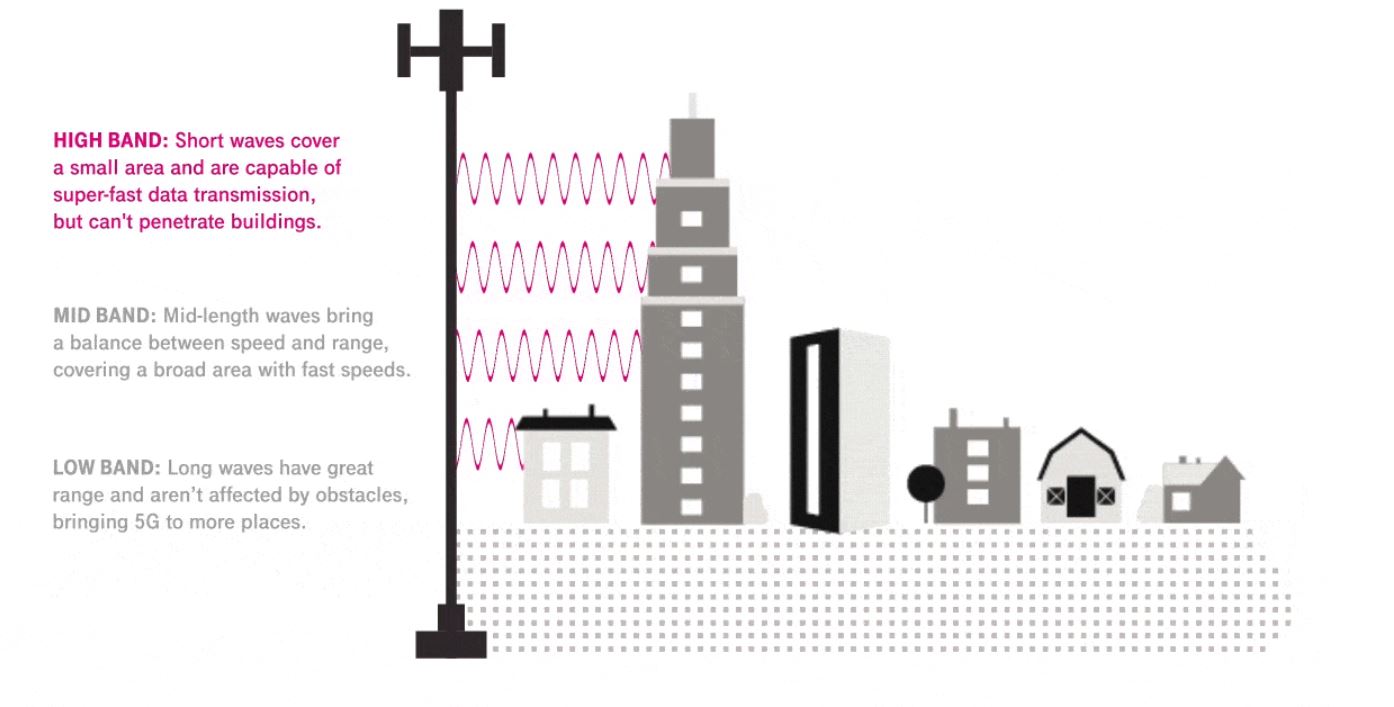
The high band, or mmWave, represents the full potential of 5G. These short waves are tricky, however, because they cover only a small area and are more likely to be affected by interference. As a result, high-band 5G will be deployed via small cells, or small antennas placed on urban structures, like streetlights and buildings. If you're lucky enough to be in a high-band 5G zone, you'll enjoy speeds of around 1 to 3Gbps, or up to 80 times faster than current 4G speeds.
5G promises to accommodate the increasing loads of connected devices that are congesting current networks. It's not only about fast speeds, but also supporting dense crowds with a reliable connection that promises ultra-low latency. As an example, where downloading a 4K video in a packed stadium might be impossible on a 4G LTE connection, it could finish almost instantly on 5G. Zero-latency gaming, truly immersive VR, driverless cars and high-res video streaming are other applications that are predicted to be enabled by 5G. And while it's not related to this specific test, 5G will also allow for a wide umbrella of IoT devices for smart cities and industries.
Sign up to receive The Snapshot, a free special dispatch from Laptop Mag, in your inbox.
How we tested
We ran three separate tests in Salt Lake City: Netflix’s Fast.com, to measure media consumption speeds; Speedtest.net, for assessing general download, upload, and ping speeds; and a file transfer test, where we timed how long it took to download the 12GB 4K video Tears of Steel from our company’s Google Drive.
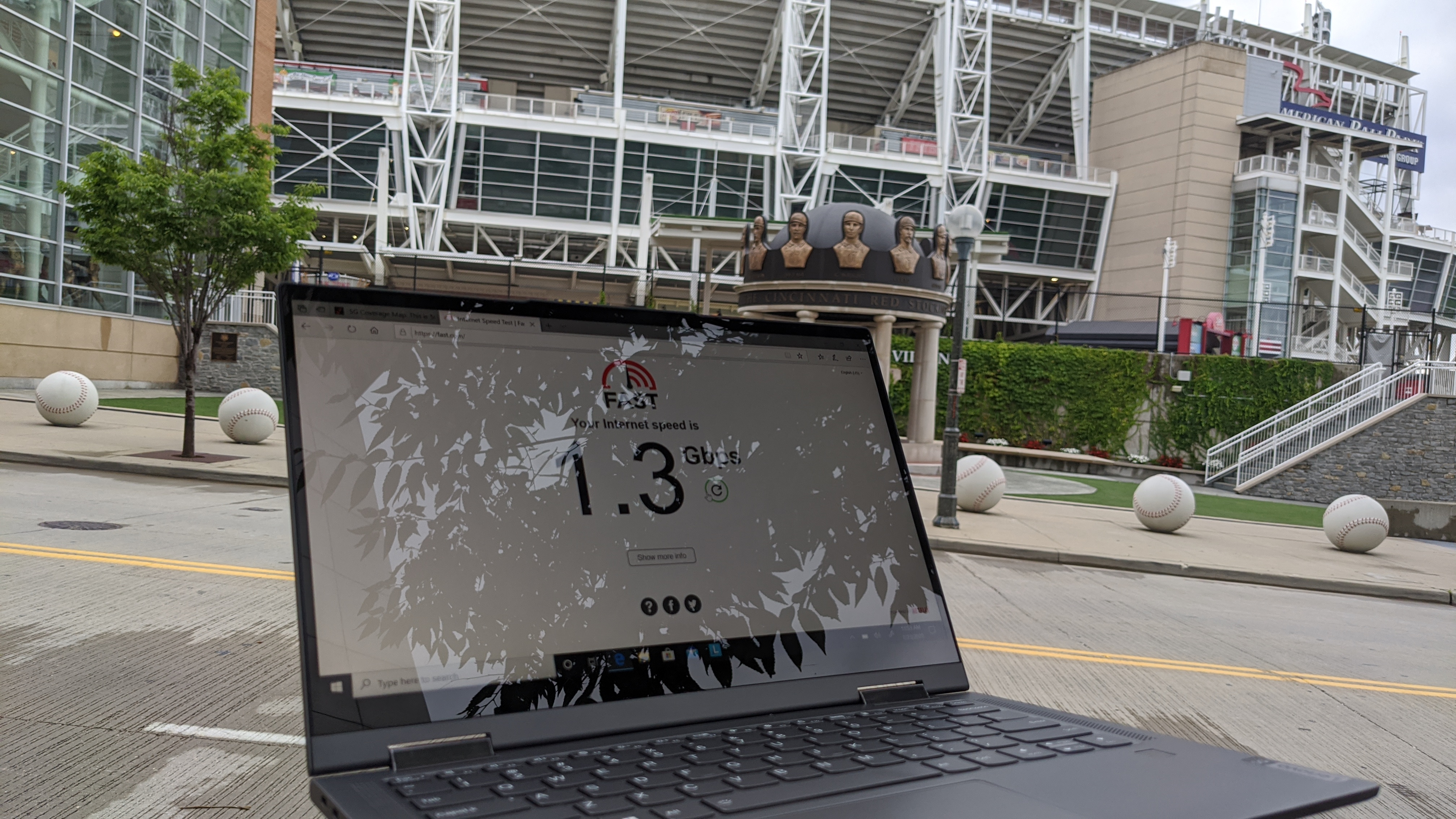
Each test was performed multiple times, to check for consistency, and in four locations throughout downtown: Verizon considered the Salt Palace Convention Center (at West Temple and South Temple), Pioneer Park (about a mile south, at 350 S 300 W), and the Vivint Smart Home Arena (301 South Temple) to be major 5G hotspots, so we tried there, along with Main Street between 200 S and 100 S, near the City Creek shopping center.
We also brought the Flex 5G to Detroit and Cincinnati to see how much speeds vary from one city to the next. In these midwestern cities, we ran Netflix's Fast.com test and the Okla Speedtest.net to get an idea of download and upload speeds and ping. Multiple tests were conducted in various locations to determine the reliability and consistency of the network.
5G in Salt Lake City
Wherever we test 5G, the story is always the same: It’s amazing… when it works. At the Convention Center, we saw download speeds upwards of 1,700Mbps on Speedtest.net — and, just a couple of minutes earlier, a download speed that barely cracked 25Mbps (no, that’s not a typo). Ditto Pioneer Park, where, without moving our car, we saw Fast.com speed veer between 7Mbps in one test to 1.1Gpbs in another. Fast.com didn’t work well at City Creek — the highest we saw there was 550Mbps — but Speedtest.net reported downloads as zippy as 1,611Mpbs.

Signals may have been wonkiest at the Vivint Smart Home Arena, where moving the car a few feet could mean the difference between registering 5G signals or not. But even when the laptop insisted we were connected at 5G, the speeds didn’t reflect this. Speedtest downloads never got above 210Mbps, Fast.com topped out at 200Mbps, and Tears of Steel wouldn’t even complete a single download after 5 minutes — even though, at the previous locations, it never took that long to download via LTE (and, at the Convention Center and City Creek, finished in a solid 1:20).
Those 5G speeds are definitely dazzling, but in testing in multiple cities throughout the United States, they haven’t proved in any way consistent. Seeing those speeds regularly—especially when you’re not even moving — should be the baseline expectation, not a delightful surprise.
5G in Detroit
I took a quick trip down to Detroit to see what sort of mobile speeds Verizon 5G is bringing to the Motor City. Verizon's network actually covers considerable ground throughout the Detroit area from downtown near Comerica Park and Hart Plaza to Ford Woods Park in Dearborn. My testing was done at Cass Park at the intersection of Temple St and Cass Ave just north of I75.
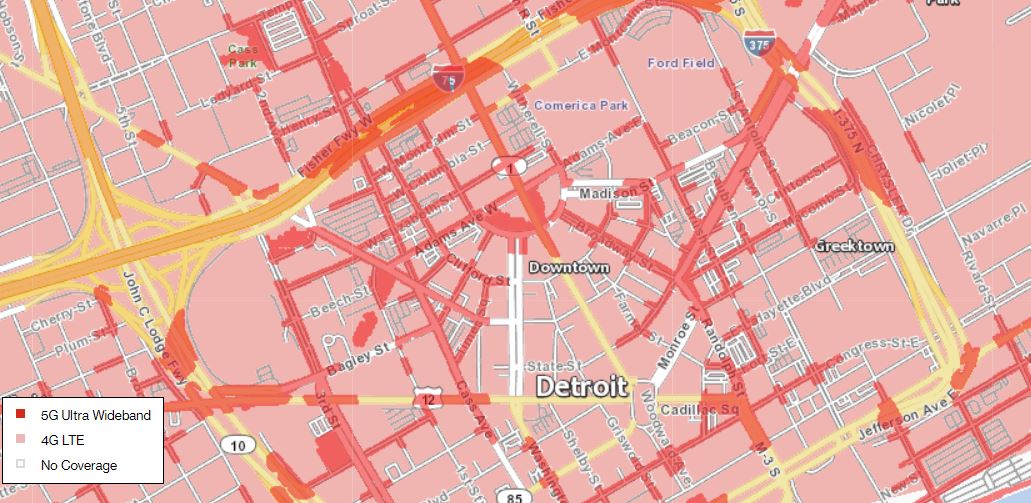
Our 5G results were similar to those we saw in Salt Lake in that the speeds were all over the place. On Fast.com, the Flex 5G clocked 1.0 Gbps flat, matching the maximum Wi-Fi fiber speeds available from most ISPs in the area. But when we ran the test again on Ookla's Speedtest, download speeds were limited to 371.7 MBps while upload speeds topped out at 29 MBps and ping stayed at around 26.
5G in Cincinnati
A quick glance at Verizon's network map placed the location of my hotel across the street from the Great American Ball Park, the home of the Cincinnati Reds and a 5G-covered area. While the coronavirus pandemic ruined any chance of me running tests inside the ballpark, the Flex 5G found a 5G signal just outside of the gates.
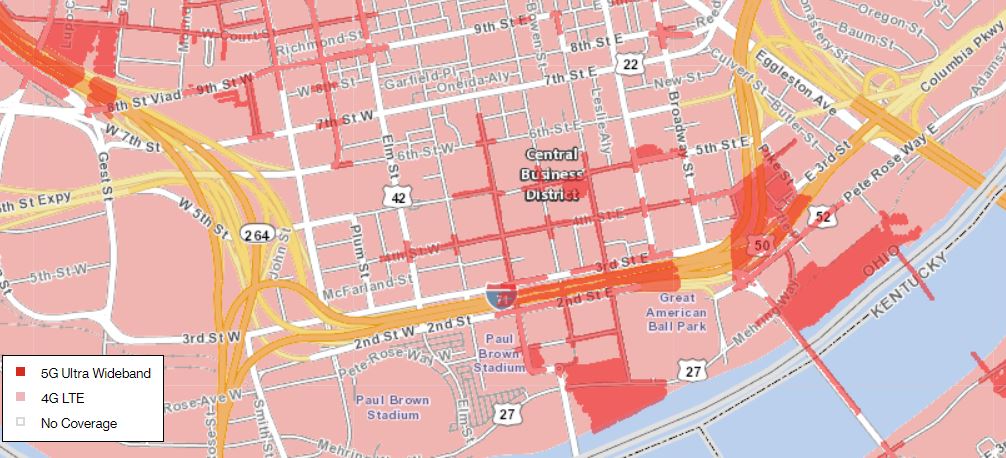
We saw download speeds of 370.1 MBps on the first speed testing using Fast.com. While considerably faster than 4G LTE, that result was the first time I achieved legitimate 5G speeds and it felt somewhat underwhelming. When I took a few paces toward the Ohio River on Joe Nuxhall Way and retried the test, the Flex 5G reached 445.6 MBps download speeds and 34.8 MBps upload speeds.
I had my first 5G "wow" during the third attempt when Fast.com clocked a blink-and-you-miss-it 1.3 gigabits per second. That is faster than even the quickest home Wi-Fi speeds and four times faster than the maximum theoretical 4G LTE download speeds. Given my proximity to the Reds baseball stadium, I can't help but compare 5G to Hall of Famer and base-stealing king Joe Morgan.
5G in New York City
For our New York City testing, we got help from Andrew Freedman, senior editor at our sister site Tom's Hardware. Freedman tried to download a 1080p video but it took five minutes, much longer than what is expected from 5G. However, downloading a 220 MB .zip file took only seconds. Uploading the file was less successful.
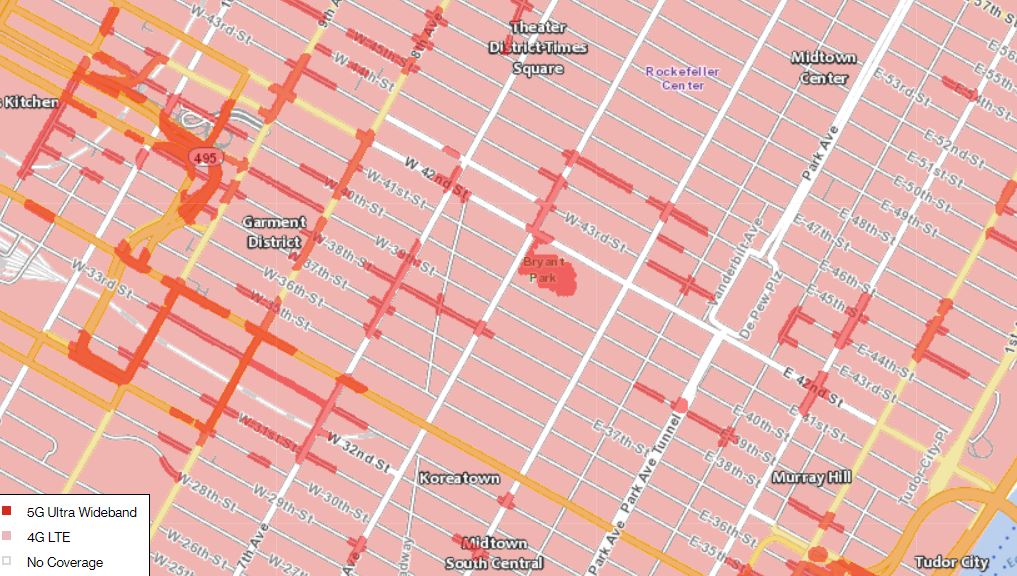
The fastest speeds Freedman clocked in New York City were 250 MBps for downloads and a measly 5 MBps for uploads. His scores reinforce our previous results, which illustrate how unreliable the network can be. Verizon clearly needs to do some optimizing if it's going to get the most out of its ultra-wideband 5G network.
Conclusion
Our 5G testing with the Flex 5G proved the next-gen mobile network has the potential to deliver data speeds that will allow us to do more on our connected devices. But I want to emphasize the word potential. Verizon's 5G network proved to be wildly inconsistent throughout our testing, dropping below 4G LTE pace at times then spiking above gigabit speeds moments later.
An even bigger issue is coverage. While AT&T, T-Mobile, and Verizon have all launched 5G networks, they are currently only available in certain cities. In the case of Verizon, 5G is only available on certain streets within specific neighborhoods of major cities. Do you live in the suburbs? Sorry, you're out of luck. That said, 5G is still very much in its infancy so, like LTE before it, we can expect a rapid expansion over the next few years.
So, should you buy a 5G laptop or smartphone? That depends. As of now, there is only one 5G laptop on the market, and it has too many shortcomings for us to recommend it. More 5G-enabled devices are on the way so you should hold off if you can. The question of whether your next smartphone should support 5G is a bit trickier. If you upgrade your phone every year or two then there isn't a need to jump on 5G right now given the limited coverage. However, if you're going to keep your phone for several years, it's a future-proof feature that is worth paying a premium to have.
Phillip Tracy is the assistant managing editor at Laptop Mag where he reviews laptops, phones and other gadgets while covering the latest industry news. After graduating with a journalism degree from the University of Texas at Austin, Phillip became a tech reporter at the Daily Dot. There, he wrote reviews for a range of gadgets and covered everything from social media trends to cybersecurity. Prior to that, he wrote for RCR Wireless News covering 5G and IoT. When he's not tinkering with devices, you can find Phillip playing video games, reading, traveling or watching soccer.

